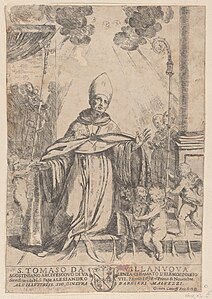Ginevra Cantofoli
Ginevra Cantofoli | |
|---|---|
 Self-Portrait, c. 1665 (detail) | |
| Born | 1618 Bologna, Italy |
| Died | 1672 (aged 53–54) |
| Nationality | Italian |
| Education | Giovanni Andrea Sirani |
| Known for | Painting |
| Movement | Baroque |
Ginevra Cantofoli (1618–1672)[1] was an Italian painter. She was active in Bologna during the Baroque period.
Career[edit]
Cantofoli was born in Bologna, Italy in 1618. She trained under Giovanni Andrea Sirani, the father of Elisabetta Sirani, in Bologna.[2] Although a generation older than Elisabetta Sirani, Cantofoli was described by Carlo Cesare Malvasia, Cesare Masini, and Marcello Oretti as Elisabetta's student.[3] Also named as her teachers are Emilio Taruffi, Lorenzo Pasinelli, and Giovanni Gioseffo dal Sole.[4]
According to art historian Laura M. Ragg, among the women painters in Bologna at the time, Cantofoli "had much more talent than any of her companions."[5]
Her early works were pastel portraits and small paintings, but she later went on to paint large-scale compositions.[4] She was primarily a history painter. She also produced several altarpieces for Bolognese churches, although none of these works are known to still exist.[6][7]
Art historian Massimo Pulini attributes 30 works to Cantofoli.[8] Among her works are a painting, Self-Portrait, Painting the Madonna of St Luke, and a drawing, Self-Portrait, which portrays the artist holding a palette and brushes before an easel, both dated to c. 1665.[9] It has also been asserted that a painting known as Allegory of Painting (in a private collection) contains a self-portrait, and that "the features of many of her female figures resemble her own."[2]
A painting of a woman in a turban in the collection of the Palazzo Barberini, traditionally identified as a portrait of Beatrice Cenci, long attributed to Guido Reni, has been attributed to Ginevra Cantofoli.
At auction[edit]
A record price for a work by Cantofoli was set by "A Sea-Nymph, probably Galatea," auctioned for $137,500 at Sotheby's, New York, January 30, 2020.[2]
Gallery[edit]
-
A Sea-Nymph, probably Galatea,[2] private collection
-
Presumed portrait of Beatrice Cenci, Palazzo Barberini
-
Scena Allegorica, private collection
-
Saint Thomas of Villanova, etching of 1658 after the painting by Cantofoli
-
Truth Revealing the Artifice of Painting, c. 1665-1672, Berkeley Art Museum
-
Self-Portrait, Painting the Madonna of Luke, c. 1665, Pinacoteca di Brera, Milan
-
Self-Portrait (drawing), c. 1665, Giorgio Cini Foundation, Venice
-
Head of a woman wearing a turban, after Guido Reni, attributed to Cantofoli, The British Museum[10]
-
A Sybil, private collection
References and footnotes[edit]
- ^ Bryan.
- ^ a b c d "Lot 146 Ginevra Cantofoli, A Sea-Nymph, probably Galatea". sothebys.com. Retrieved March 3, 2022.
- ^ Bohn, p. 266.
- ^ a b "Cantofoli, Ginevra". Benezit Dictionary of Artists. 2011. doi:10.1093/benz/9780199773787.article.B00031527. Retrieved March 5, 2022.
- ^ Ragg, p. 242, who also says that Cantofoli was "sometimes, but groundlessly, represented as Elisabetta's enemy and rival."
- ^ Bohn, p. 266-267.
- ^ Bryan lists three works once known to have existed: A Last Supper for the Church of San Procolo, a St. Thomas of Villanova for San Giacomo Maggiore, and a St. Apollonia for the Church of La Morte.
- ^ Pulini (2006).
- ^ Bohn, pp. 267-269, with black and white reproductions of both painting and drawing.
- ^ "Museum number SL,5236.152". britishmuseum.org. Retrieved March 5, 2022.
Sources[edit]
- Bohn, Babette. "Female Self-Portraiture in Early Modern Bologna", Renaissance Studies, Vol. 18, No. 2 (June 2004), pp. 239–286
- Bryan, Michael. "Cantofoli, Ginevra" in Bryan's Dictionary of Painters and Engravers, Biographical and Critical, London: George Bell and Sons, 1899, Vol. I: (A-K), p. 227.
- Pulini, Massimo (2006). Ginevra Cantofoli: la nuova nascita di una pittrice nella Bologna del Seicento, Bologna 2006.
- Ragg, Laura M. The Women Artists of Bologna, London: Methuen & Co., 1907.
Further reading[edit]
- Bohn, Babette. Women Artists, Their Patrons, and Their Publics in Early Modern Bologna, Penn State University Press, 2021.
- Graziani, Irene (2008). "Ginevra Cantofoli, Madonna col Bambino, no. 268," in Pinacoteca Nazionale di Bologna. Catalogo generale, vol. 3, Guido Reni e il Seicento, Venice: Marsilio, 2008, pp. 450–451.
- Graziani, Irene (2014). "Ginevra Cantofoli, Sibyl of Eritrea," in Angelo Mazza, ed., Antico e Moderno. Acquisizioni e donazioni per la storia di Bologna (2001-2013), catalogue for the exhibition in Bologna, Palazzo Fava, 27 June-28 September 2014, Bologna: Bononia University Press, 2014, pp. 94–95.
- Italian Cultural Institute, London. Diacromie. Dialogie e Derive. Collezione Koelliker, catalogue of exhibition 19 October-29 November 2006, n.p. (Sea-Nymph reproduced in color).
- Pulini, Massimo (2004a). "1656. Ritratto di Ginevra Cantofoli pittrice," in J. Bentini and V. Fortunati, eds., Elisabetta Sirani "pittrice eroina" 1638-1665, exhibition catalogue, Bologna 2004, pp. 134–141.
- Pulini, Massimo (2004b). "Un'altra donna pittrice nel Seicento," in Avvenire, December 19, 2004, p. 22.
External links[edit]
- The Mystery of Ginevra Cantofoli by Amanda Hickey; includes a comment thread by Alan Templeton.

![A Sea-Nymph, probably Galatea,[2] private collection](http://upload.wikimedia.org/wikipedia/commons/thumb/0/07/A_SEA-NYMPH%2C_PROBABLY_GALATEA.png/248px-A_SEA-NYMPH%2C_PROBABLY_GALATEA.png)






![Head of a woman wearing a turban, after Guido Reni, attributed to Cantofoli, The British Museum[10]](http://upload.wikimedia.org/wikipedia/commons/thumb/f/ff/Ginevra_Cantofoli--head_of_a_woman_in_red_chalk--British_Museum.jpg/318px-Ginevra_Cantofoli--head_of_a_woman_in_red_chalk--British_Museum.jpg)
